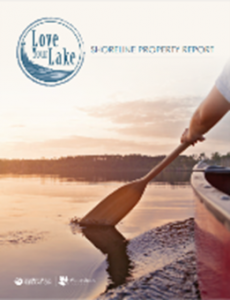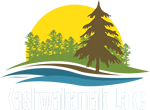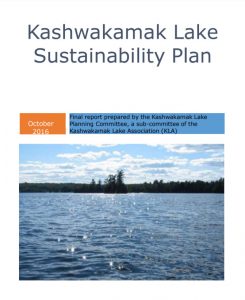Sustainability of Our Lake
Volunteers Making A Difference!
Current
Phase 4: Implementation
We are currently in the fourth and final phase of Lake Sustainability Planning. Implementation of the Kashwakamak Lake Sustainability Plan, (which was approved unanimously at the 2016 AGM), began in 2017. Here’s a list of our implementation activities to date:
2024: Continued Focus on Shoreline Health – MVCA/Kaskwakamak Lake Shoreline Planting Project
In partnership with the KLA, Mississippi Vally Conservation Authority (MVCA) is helping Kashwakamak Lake property owners add plants to their shorelines this spring. Participating waterfront property owners have the opportunity to order up to 15 trees/shrubs for a $25 donation to MVCA’s stewardship program.
KLA Lake Sustainability
As part of the KLA’s ongoing Lake Sustainability efforts to improve shoreline health and water quality, the KLA will donate $10 to MVCA’s stewardship program for every order from a current Kashwakmak Lake Association member, up to a maximum of $2,000/200 KLA property owners. This means current KLA members can choose to donate a minimum of $15 for their order, but we encourage you to donate $25 and get a charitable receipt. The KLA will still make the $10 donation for members who choose to donate $25.
Some details:
Waterfront property owners must be on Kashwakamak Lake, and plants must be planted within 45 m of the lake. If a property owner wants more than 15 plants, additional plants are available at cost (approximately $3 each). Property owners who are interested in having a larger shoreline planting doe should contact Kayla Cuddy, kcuddy@mvc.on.ca, for more information on their Shoreline Naturalization Program and planting assistance.
Click these links for the options to choose from:
MVCA Shoreline Planting Program Information Sheet
MVCA Lake Tree Days Order Form
Don’t miss out – first come, first served!
All orders must be submitted no later than Tuesday, March 5 along with your plant order sheet and donation. Plant pick-up by road or water is on Saturday, June 1 between 11:00 am – 2:00 pm at either Woodcrest Resort or Fernleigh Lodge. More pick-up information will follow closer to the date.
More information:
Kayla Cuddy, kcuddy@mvc.on.ca
Questions on the status of your KLA membership, email Don Cory, membership@kashwakamak.ca
2023: Focus on Shoreline Health
The KLA’s focus for Lake Sustainability in 2023 was Shoreline Health – Creating a Natural Ribbon of Life. We shared information from the Love Your Lake Shoreline Assessment and encouraged property owners to learn more about what they could do to enhance their shoreline health. We also had Melissa Dekkers, Watershed Canada, as a keynote speaker for the July 2023 AGM, where she shared the highlights of Kashwakamak Lake’s Shoreline Assessment. You can see her presentation here: https://kashwakamak.ca/love-your-lake-natural-is-beautiful/
We also held a contest for 3 lucky KLA members to win a free Natural Edge Shoreline Assessment and Planting Kit, (valued at $395 each). It included a site visit from Watershed Canada to discuss their shoreline, a detailed personalized planting plan to help improve their shoreline and a selection of plants to get them started. Two of the three winners had their assessment and did their plantings in the fall of 2023. The other winner is getting theirs done in the spring of 2024. We can’t wait to see the results!
Catch up on the 2023 Healthy Shoreline articles here:
https://kashwakamak.ca/tag/healthy-shorelines/
https://kashwakamak.ca/kla-update-part-2-shoreline-health/
https://kashwakamak.ca/kla-update-shoreline-health-part-3-the-ribbon-of-life/
New for 2022: The Natural Edge Program
As part of our continued focus on Lake Sustainability, and in follow up to the 2020 Love Your Lake Shoreline Assessment, the KLA encouraged property owners to take advantage of an exciting (free) opportunity available through The Natural Edge Program. It is a Not-for-profit shoreline naturalization program available to property owners in our area to plant native trees, shrubs, groundcovers, wildflowers, and grasses along the water’s edge. Some property owners on the lake took part in this great program in the past.
As you know, shorelines are among the most important places on earth for wildlife. Healthy layers of shoreline vegetation benefit wildlife, protect our Kashwakamak Lake shorelines from degrading, and support natural processes that are essential to maintaining our healthy lake!
Next steps:

Review your property’s 2020 Shoreline Assessment Report and determine if this program is for you.
Contact https://naturaledge.watersheds.ca/contact/ now to make a booking for the summer of 2022.
2021: Each individual property owner received a copy of their individual shoreline report this spring. The KLA received the Kashwakamak Lake Values Survey/Lake Summary Report in December 2021. This report will help the KLA determine opportunities for restoration, education, and stewardship on a lake-wide level. Over the winter months, the Water Quality & Shoreline Protection & Health Sub-committee will be carefully reviewing the final report, and making recommendations to the board for possible shoreline stewardship initiatives for 2022 and the years following. We are hoping to get a LYL presentation included as part of our 2022 AGM so members can get their questions answered. Click the image to read or download the Kashwakamak Lake Values Survey/Lake Summary Report.
2020: The KLA Board agreed in 2019 to implement the Love Your Lake Shoreline Assessment. The LYL program promotes shoreline stewardship and supports the implementation of Issue 3 (p. 20 of the Lake Sustainability Plan) “Protect, maintain and improve the water quality of Kashwakamak Lake” and Issue 6 (p. 25) “Increase community awareness regarding shoreline protection and health.” The LYL program helps shoreline property owners protect and restore their shorelines and maintain their property in an environmentally responsible way, thereby improving the health of their lake. Our LYL shoreline assessment took place over 13 days in July 2020. In all, 595 properties were assessed totalling about 46 km of shoreline on Kashwakamak Lake.
2018: The KLA assisted the Mississippi Valley Conservation Authority’s (MVCA ) in distributing 886 free trees and shrubs to property owners as part of the efforts being taken to maintain and enhance the lake water quality and shoreline. Part of the action plan included shoreline tree and shrub planting in 2018.
In June 2018, the Flora & Fauna sub-committee launched the online survey Let’s Get Tracking! It’s an ongoing, online database to track plants and wildlife. It will help the KLA track threatened or endangered species, as well as keep an eye on species of “special concern”. People are also asked to email their photos, along with the date they were taken to: tracking@kashwakamak.ca
Get started here: https://www.surveymonkey.com/r/KLATracking
Background: KLA members received a Lake Sustainability package in June 2017 which included: a printed copy of the plan along with key Lake Sustainability information, (Boating Etiquette, Protecting our Loons) and an important flyer and information on Septic Systems). The KLA hopes that this information will sit on every coffee table on the lake and garner good discussion!
Additional printed copies of the Lake Sustainability Plan are available for $10 a copy. Please contact Judy McIntyre, at 613-336-2882 or email
The final, approved Kashwakamak Lake Sustainability Plan is also available online.

Click here to learn more about How it works.
The Natural Edge program can provide you with:
- A free site visit to discuss shoreline concerns, provide recommendations, and assess planting conditons;
- A personalized planting plan, including photos of selected planting areas and ideal plant species;
- Free resources to ensure that the newly planted vegetaion thrives in the first few years of establishment and growth; and
- Follow-up and support with your new plants.
- If you choose, you can purchase the Shoreline Re-Naturalization Starter Kit for $250 (subsidized plant costs)
Read more here: The Natural Edge Program Brochure
Summer 2022 – limited spots available – Interested?
Don’t wait! Contact https://naturaledge.watershed.ca/contact/ to make a booking for the summer of 2022. (psst some of your colleagues on the Lake have already booked a visit!).
Click the image to read or download the Kashwakamak Lake Values Lake Summary Report.
Love Your Lake: Accessing your property’s 2020 Shoreline Assessment
 Every property owner on the lake received an email from LYL in April 2021 with an option to download a PDF of their personal Shoreline report or purchase a printed copy.
Every property owner on the lake received an email from LYL in April 2021 with an option to download a PDF of their personal Shoreline report or purchase a printed copy.
Can’t find your report?
Please contact:
Melissa Dakers (she/her)
Habitat and Stewardship Program Manager
Watersheds Canada
115-40 Sunset Blvd, Perth, ON K7H 2Y4
O: 613-264-1244 , dakers@watersheds.ca , watersheds.ca
 Let’s Get Tracking!
Let’s Get Tracking!
Flora & Fauna Sightings on Kashwakamak Lake
Get Started Here:
Background
Phase 1: Research
The proposal to begin a lake sustainability planning process, (also known as “lake planning”), was approved at the July 2011 KLA Annual General Meeting, (AGM) with the understanding that the plan would need to be approved by the KLA membership once it was completed.
Following the July 2011 AGM, the volunteer Lake Sustainability Planning committee was set up. This dedicated group of volunteers started the process of gathering information from the community to understand the key values and concerns. They drafted and conducted surveys with the KLA members and the surrounding lake community, as well as a separate survey with local businesses. The key purpose of the surveys was to find out what people valued about the lake community and what their issues were. The survey ran from late summer to the end of 2011. The results of this research was presented and discussed at the 2012 KLA AGM.
Following the survey, the Lake Sustainability Planning Committee began the endeavour of capturing what we know about the lake in a “State of the Lake Report.” The purpose of this report is to let us know where we are at a given time and place – a benchmark that can be used for reference moving forward.
Highlights of the ‘State of the Lake Report’ were then presented at the July 13th 2013 AGM. The full State of the Lake Report as well as a summary of the report are available on line. This was the first step in preparing a lake sustainability plan.
Phase 2: Analysis
During the next two years, 2014 – 2015, the committee got to work analysing all the feedback and themes that emerged from the research phase. Many committee meetings were held throughout the off-season to discuss the direction of the lake sustainability plan, experiences from other nearby lakes etc. This information and observations were shared with KLA members and the community via emails, articles in the association newsletter, The Kash Kourier, as well as on the KLA’s website. In the spring of 2014 the KLA conducted a second survey with the Kashwakamak Lake community. People were asked to read the State of the Lake Report as the questions in this survey related specifically to the information compiled in the report.
Phase 3: Planning
Early in 2015, The Lake Sustainability Planning committee met to begin the next phase of the process: drafting the Lake Plan. Over the summer months, a draft was compiled building off the 2013 State of the Lake Report. The draft lake sustainability plan was circulated in the fall of 2015 asking for community feedback and questions.
Based on comments and feedback, the final draft of the Kashwakamak Lake Sustainability Plan was formally presented at the July 9th, 2016 AGM. Following the presentation by Scott Bennett, KLA members and others in the community discussed the issues and recommendations. KLA members then voted unanimously to approve the plan in principle.
Phase 4: Implement & Monitor
Following the vote at the July 2016 AGM volunteers were also recruited to help implement the plan. The “Planning” committee became the “Implementation” committee and three broad implementation sub-committees were set up in the fall of 2016. These sub-committees are good umbrellas to begin implementing key parts of the plan where volunteer interest was expressed. There are now volunteers who have come forward to help with implementing some aspects of the plan. As a living plan, implementing the Kashwakamak Lake Sustainability plan will be on-going for many years. New volunteers will emerge as issues they are passionate about come forward for implementation. Updates will be provided at every AGM and the plan will be revisited and updated every five years.
Volunteers making a difference
The Kashwakamak Lake Sustainability Implementation Committee has evolved over the years. Its current members include: Judy McIntyre, Peter Burbidge and Sue MacGregor. Alyson Simon, (MVCA) and Scott Bennett both serve as advisors to the committee.
The current Implementation Sub-Committees are:
1. Water Quality and Shoreline Protection and Health
Focus is on water quality monitoring, development pressures, shoreline erosion.
Members: Peter Burbidge, Jane Latimer, Heather Nowlan and Wes Plant. Advisors – Pete Johnson, KLA Lake Steward and Alyson Symon, MVCA.
Information: Boating Etiquette
2. Flora, Fauna, Wildlife & Forestry
Focus is on fire prevention and wildlife protection.
Members: Judy McIntyre, Kim Howson, Trisha Hedges and Jeannie Brejak.
Information: Protecting our Loons
3. Communications
Focus is on developing a welcome package, grant writing, and communicating the priorities of the other sub-committees via current KLA communication vehicles including: social media, member emails, KLA newsletter, education/outreach and presentations.
Members: Sue MacGregor, Heather Nowlan, Meaghan Craven and Chris Winney.
Scott Bennett is now serving as an advisor to the Implementation committee for planning purposes.
Want to get involved?
We’ve had quite a number of people express interest in getting involved in the implementation of the plan, but we can always use more. We know that our KLA members have a diverse set of talents, areas of expertise and interest that could support our implementation efforts. As you can see from our first 3 committees, there are many ways and areas to get involved.
People want to be part of the implementation, (however much time you might have), are asked to Email
Lake Sustainability Research
Below is the research involved in the Lake Planning process since 2011:
2011 – Proposal – http://www.slideshare.net/Scott_A_Bennett/kashwakamak-lake-sustainability-plan-proposal-july-2011
2012 – Research – http://www.slideshare.net/Scott_A_Bennett/kaswakamak-lake-sustainability-plan-july-2012
2013 – State-of-the-Lake – http://www.slideshare.net/Scott_A_Bennett/kaswakamak-lake-sustainability-update-july-2013
kashwakamak-lake-sustainability-plan-october-2016_final-online
2016 Lake Sustainability Plan AGM presentation – http://www.slideshare.net/Scott_A_Bennett/approved-kashwakamak-lake-sustainability-plan-july-2016
https://www.slideshare.net/Scott_A_Bennett/approved-kashwakamak-lake-sustainability-plan-july-2016 made during the July 2016 AGM
Lake Sustainability Documents:
Kashwakamak Lake Sustainability Plan
State of the Lake Report Summary
Love Your Lake Latest Update – Interim Report
Kashwakamak Lake Values Survey/Lake Summary Report













 Let’s Get Tracking!
Let’s Get Tracking!